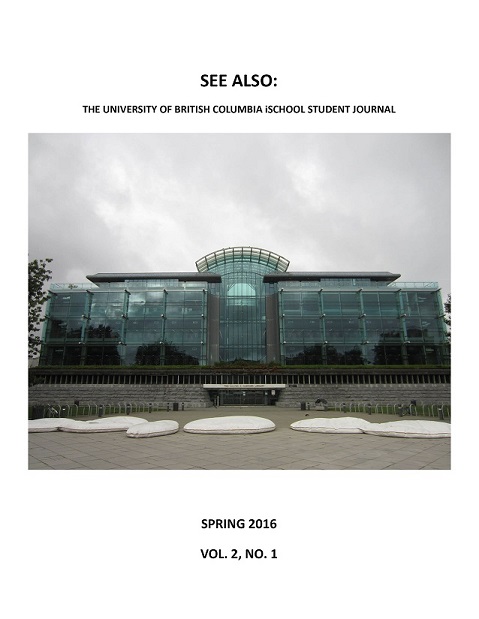A Legal, Ethical, & Technological Dilemma: Internet Filtering for Explicit Content in Public Libraries
DOI:
https://doi.org/10.14288/sa.v0i2.187521Keywords:
censorship, collection development, InternetAbstract
This literature review, originally written in February 2015 to satisfy course requirements for LIBR 505: Research Methods in Information Organizations, explores various aspects of the debate surrounding Internet filtering for explicit content on public library computers in North America, with a focus on libraries and legislation in the United States. The literature examined extends from the early 2000s to the present.References
Adamson, W. (2002). Sex in the city: What happened at the Minneapolis Public Library. NewBreed Librarian, 2(2). Retrieved from http://hdl.handle.net/1794/1113
American Library Association. (2012). A FAQ on library filtering policies in Washington state. Retrieved from http://connect.ala.org/files/28462/Exhibit_I_FilteringPacket.pdf
Bell, Bernard W. (2000). Filth, filtering, and the First Amendment: Ruminations on public libraries' use of internet filtering software. Federal Communications Law Journal, 53, 191-237. Retrieved from http://heinonline.org
Berry, J. (2002). Fear of information. Library Journal, 127(7). Retrieved from http://search.proquest.com.ezproxy.library.ubc.ca/docview/196849559?accountid=14656
Bravard, R. S. (1989). Actualities of regulating pornography. Collection Building, 9(2), 33-35.
Cannan, John (2010, June 15). United States: Washington State Supreme Court Upholds Library’s Internet Filtering Policy. Retrieved from http://www.loc.gov/law/foreign-news/article/united-states-washington-state-supreme-court-upholds-librarys-internet-filtering-policy/
Chambers, J., Halley, P., Hone, L., & Eberle, C. (204, August 6). E-rate Modernization [Webinar]. Retrieved from http://www.districtdispatch.org/2014/08/e-rate-never-sleeps/
Chmara, T. (2012). Library internet filtering update. Retrieved from http://c.ymcdn.com/sites/www.ftrf.org/resource/resmgr/docs/libraryfilteringupdate_july_.pdf
Cohen, H & Minow, M. (2006). Intellectual freedom in libraries: Then and now. Advances in Librarianship, 30, 73-101. Retrieved from http://dx.doi.org/10.1016/S0065-2830(06)30002-5
Curry, A. (2000). What are public library customers viewing on the internet?: An analysis of Burnaby transaction logs. Submitted to the Burnaby Public Library.
Dilevko, J. & Gottlieb, L. (2004). Selection and cataloging of adult pornography web sites for academic libraries. The Journal of Academic Librarianship, 30(1), 36-50. Retrieved from http://heinonline.org/HOL/Page?handle=hein.journals/drklr51&collection=journals&page=213
Estabrook, L. S. & Lakner, E. (2000). Managing internet access: Results of a national survey. American Libraries, 31(8). Retrieved from http://www.jstor.org/stable/25637759
Hougton-Jan, S. (2010). Internet Filtering. Library Technology Reports, 46(8), 25-33. Retrieved from http://search.ebscohost.com/login.aspx?direct=true&db=eue&AN=503003767&site=ehost-live&scope=site
Laughlin, G. K. (2003). Sex, lies, and library cards: The First Amendment implications of the use of software filters to control access to internet pornography in public libraries. Drake Law Review, 51, 213-282. Retrieved from http://heinonline.org
Pautz, H. (2013). Managing access to the internet in public libraries. New Library World, 114, 308-318. Retrieved from http://search.proquest.com.ezproxy.library.ubc.ca/docview/1399602316?accountid=14656
Pors, N. (2001). Misbehaviour in the public library: internet use, filtering, and difficult people. New Library World, 102(9), 309-313. Retrieved from http://dx.doi.org/10.1108/EUM0000000005899
Skaggs, J. (2003). Burning the library to roast the pig? Online pornography and internet filtering in the free public library. Brooklyn Law Review, 68(3), 809-852. Retrieved from http://heinonline.org.ezproxy.library.ubc.ca/HOL/Page?handle=hein.journals/brklr68&collection=journals&page=809
Spacey, R., Cooke, L., Muir, A. & Creaser, C. (2014). Regulating use of the internet in public libraries: A review. Journal of Documentation, 70, 478-497. Retrieved from http://dx.doi.org/10.1108/JD-02-2013-0021
Theyer, H. (2000). A librarian's right to comfort. American Libraries, 31(6). Retrieved from http://www.jstor.org/stable/25637669
Trushina, I. (2004). Freedom of access: ethical dilemma for internet librarians. The electronic library, 22(5), 416-421. Retrieved from http://www.emeraldinsight.com/doi/full/10.1108/02640470410561938
Wardak, L. (2003). Internet filters & the First Amendment. Loyola University Chicago Law Journal, 35, 657-735. Retrieved from http://heinonline.org
Young, G. (2003). No smut at work, please. National Law Journal. Retrieved from http://www.nationallawjournal.com/id=900005393712/No-smut-at-work-please?slreturn=20150113192910
Published
Issue
Section
License
All authors in See Also retrain full copyright of their material.
All content in See Also is published under an Attribution-NonCommercial-NoDerivatives 4.0 license.
Under this license you are free to:
Share — copy and redistribute the material in any medium or format
Under the following terms:
Attribution — You must give appropriate credit, provide a link to the license, and indicate if changes were made. You may do so in any reasonable manner, but not in any way that suggests the licensor endorses you or your use.
NonCommercial — You may not use the material for commercial purposes.
NoDerivatives — If you remix, transform, or build upon the material, you may not distribute the modified material.
- No additional restrictions — You may not apply legal terms or technological measures that legally restrict others from doing anything the license permits.

